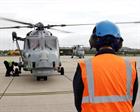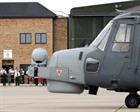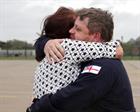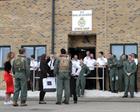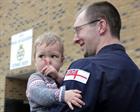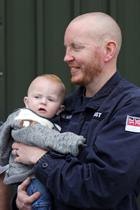HMS DUNCAN'S WILDCAT GUARDIANS RETURN IN TRIUMPH
FLIERS who helped protect more than one million tonnes of British shipping in the Gulf today returned in triumph to Yeovilton.
The aviators of 202 Flight touched down at the home of their parent 815 Naval Air Squadron in Somerset, a six-month mission in the Mediterranean, Black Sea and finally Strait of Hormuz with destroyer HMS Duncan.
With the mother ship sailing back to Portsmouth tomorrow, the Flight left the destroyer in the Channel and returned to base in their state-of-the-art Wildcat where they were eagerly awaited by excited loved ones, friends and colleagues.
Duncan deployed in March and initially joined the French aircraft carrier Charles De Gaulle as part of her multinational carrier strike group GAN 19. The group then proceeded to the coast of Syria for Operation Inherent Resolve, with Duncan providing air defence to the group as part of operations against ISIS forces in the region.
May and June saw ship and helicopter committed to various NATO exercises in humanitarian aid and counter human/arms-trafficking before joining Standing NATO Maritime Group 1 for Exercise Sea Breeze in the Black Sea where, once again, she was employed in her air-defence role.
The most demanding period for the flight and ship’s company came at the tail end of the deployment when Duncan broke away from the NATO force and sailed through Suez to support HMS Montrose in the Strait of Hormuz, accompanying British-flagged merchant ships through the narrow waters which act as the gateway to and from the Gulf.
On each of the 29 transits of Hormuz, the Wildcat was used to scour an area roughly twice the size of Wales for any potential threats to the destroyer and the tankers and cargo vessels.
As a result of the combined efforts of ship and helicopter, 1.2m tonnes of merchant shipping safely transported their cargoes into our out of the Gulf.
As hard as that was for the fliers in the helicopter, it was equally punishing for the engineers and technicians maintaining the aircraft on board; temperatures in the hangar often touched 60 Celsius by day.
“It has been a challenging – but rewarding – time in which the aircraft and its capability have been a cornerstone of the ship’s output,” said Flight Commander Lieutenant Jonny Hamlyn.
“Whilst operating in the Eastern Mediterranean with the French Task Group we kept tabs on the movements of Russian warships, later whilst working for NATO we tracked suspect vessels and provided overwatch for boarding operations.
“Finally, in the Gulf we were a key player, providing force protection for both HMS Duncan and merchantmen under escort.”



